Ask a question from expert
Report on Data Analysis and Design- Fast Track Health Centre
23 Pages5165 Words232 Views
Added on 2019-12-03
Report on Data Analysis and Design- Fast Track Health Centre
Added on 2019-12-03
BookmarkShareRelated Documents
Data analysis and design

Table of ContentsINTRODUCTION...........................................................................................................................1TASK 1............................................................................................................................................11.1 Critical comparison between different data models and schemas.........................................11.2 Critical discussion of benefits and limitations of different database technologies................31.3 Analyze different approaches to database design..................................................................41.4 Explain top-down and bottom-up approaches.......................................................................6TASK 2............................................................................................................................................72.1 Design a relational database system to meet a given requirement........................................72.2Building a relational database system based on a prepared design.......................................42.3 A range of database tools and techniques to enhance the user interface...............................42.4 Crow’s foot notation..............................................................................................................42.5 Critical reflection...................................................................................................................6TASK 3............................................................................................................................................63.1 Benefits of using manipulation and query tools....................................................................63.2 Implementation of a query language into the relational database system.............................73.3 Critically evaluation of query tools used in data extraction..................................................83.4 Advantages of query in database...........................................................................................8TASK 4............................................................................................................................................84.1Review and test a relational database system........................................................................84.2 Documentation to support the implementation and testing of a relational database.............94.3 User documentation for a developed relational database system..........................................94.4 Explain the ways through which verification and validation has been addressed.................9
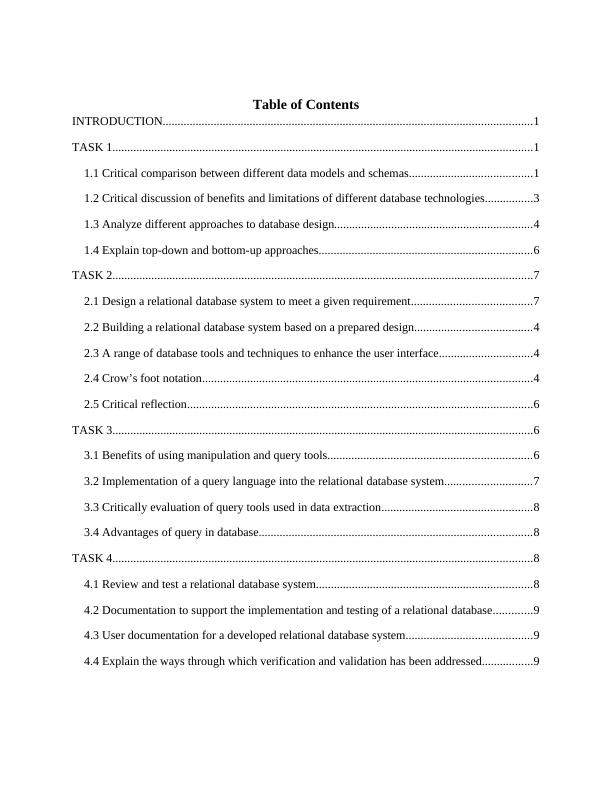
4.5 Control mechanisms..............................................................................................................94.6 Testing and implementation of database system.................................................................104.7 Appropriate decisions to improve present system...............................................................10CONCLUSION..............................................................................................................................11REFERENCES..............................................................................................................................123
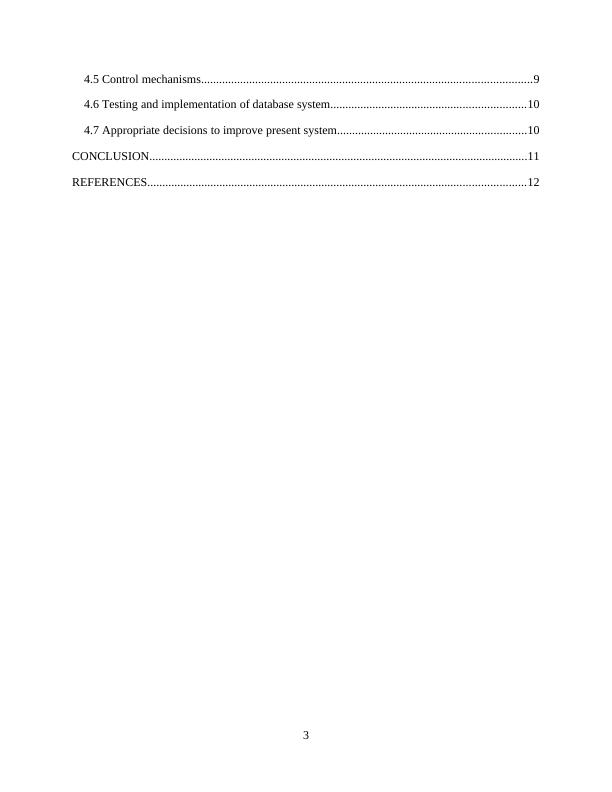
List of figuresFigure 1: File management system (data redundancy)....................................................................7Figure 2: Database management (data redundancy)........................................................................7Figure 3: Data flow diagram............................................................................................................8Figure 4: Entity relationship diagram..............................................................................................9Figure 5: Top-down approach.........................................................................................................9Figure 6: Bottom-up approach.......................................................................................................10Figure 7: 0-Level DFD..................................................................................................................13Figure 8: 1-Level diagram.............................................................................................................13Figure 9: Patient enquiry form.......................................................................................................14Figure 10: Testing and implementation of database......................................................................20List of tables Table 1: Database schema..............................................................................................................6Table 2: Conceptual data model....................................................................................................10Table 3: Logical database design...................................................................................................11Table 4: Crow’s Foot notation.......................................................................................................15Table 5: Speciliast_details table....................................................................................................17Table 6: Room_details...................................................................................................................17Table 7: Patient_details table.........................................................................................................17Table 8: Recpt and FTHC_details table.........................................................................................17Table 9: Verification and Validation table....................................................................................19
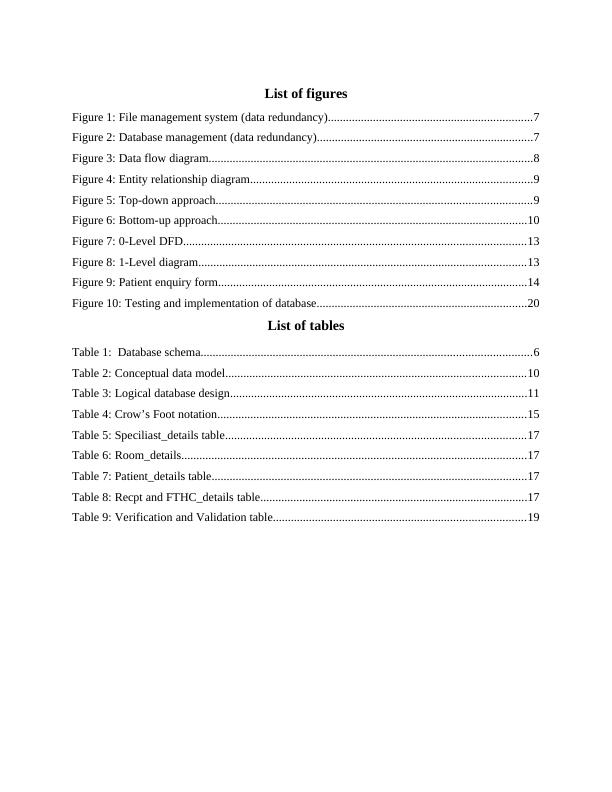
INTRODUCTIONData analysis and design is an important problem solving technique and it allowsdatabase users to maintain records or details without any redundancy. As per the present casescenario, Fast Track Health Centre (FTHC) has been taken into consideration which providesquality of services to its patients and operated by health care professionals. Furthermore, reportprovides details about different data models and approaches of database design with the help ofdiscussing some real world’s problems in a significant manner. In addition, relationship databasedesign and database system on the base of given case study have been discussed.TASK 11.1 Critical comparison between different data models and schemasDifferent data models can be used for the purpose of fetching data from database andpresenting it to users.. On the basis of data structures, data manipulation and data integrity,critical comparison between data models can be done. In Hierarchal model, data presents to userin hierarchal structure or a sort of inverted tree. Data structure: It has records, nodes and fields. In hierarchal structure, data is stored inthe form of family tree and nodes are arranged in the parent and child data segments. Inaddition, one to many or one to one relationship exists in this model. On the other side, innetwork model, multiple branches are emanating from one or more nodes and it can beshown by an arrangement of the blocks (Wasson, 2006). In order to represent thedatabase of the organization, blocks, areas and arrows have been used. It is based on theparent child relationship and supports many to many relationships. In relationshipdatabase model, each record can have multiple parents and multiple child records(Jonathan, 2008).Data manipulation: Independent stand alone query interface is not provided in thehierarchical model. While in network model, CODASYL(Conference on Data SystemsLanguages) is employed for the purpose of fetching information a. On the other side, inrelational database, SQL language and other query languages are used to manipulate datastored in the database (Coronel and Morris, 2014). On the basis of critical comparisonbetween these data models, it can be said that retrieve algorithms are complex andsymmetricin the case of both network and hierarchal models.1
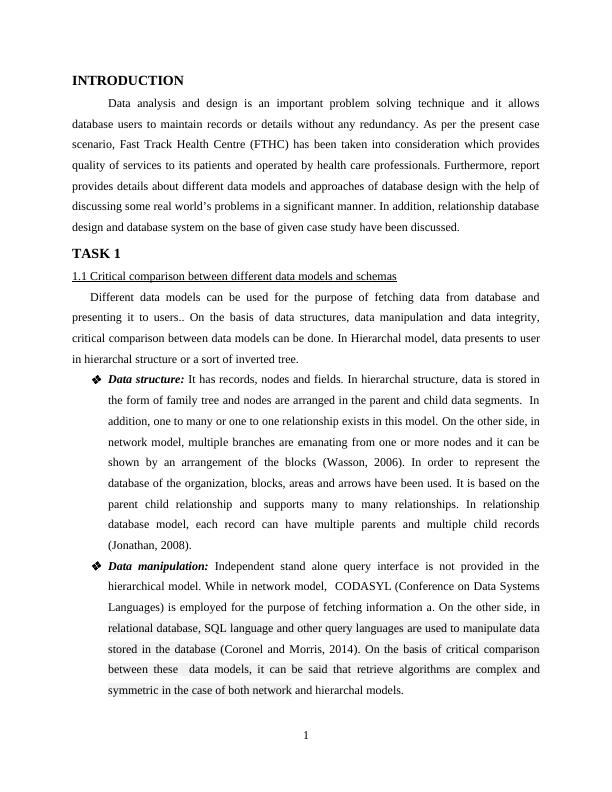
Data integrity: The main restriction which is associated with hierarchal model is thatdatabase user cannot insert the information of a childwho does not have any parent. Onthe other hand, network model and relationship models are not suffered from anyinsertion anomaly (Ramakrishnan, 2007). Deletion related constraints which includedeletion of parent results in deletion of child records is also attached with hierarchalmodel but other network models not suffered from any kind of delete anomalies.Table 1: Database schemaFactors Conceptual schemaLogical schemaPhysical schemaDefinitionIt represents that howthe business world seesinformation. It is madeout of actually whatdatabase user has plan.It is concerned with theviews of real world(Westman, 2001).In this schema,generalizedformalstructure is used in whichthe rules of informationscience are defined.Real time execution of data andfeatures are defined in thisschema.ComplexitylevelLess complexModerateHigh complex (Ranjit, 2006)Features Table, table space, viewand packages Fully normalized entities,logical domains and datatypes.Index, key, alternate key andreferential integrity, views andconstraintsStructure 2
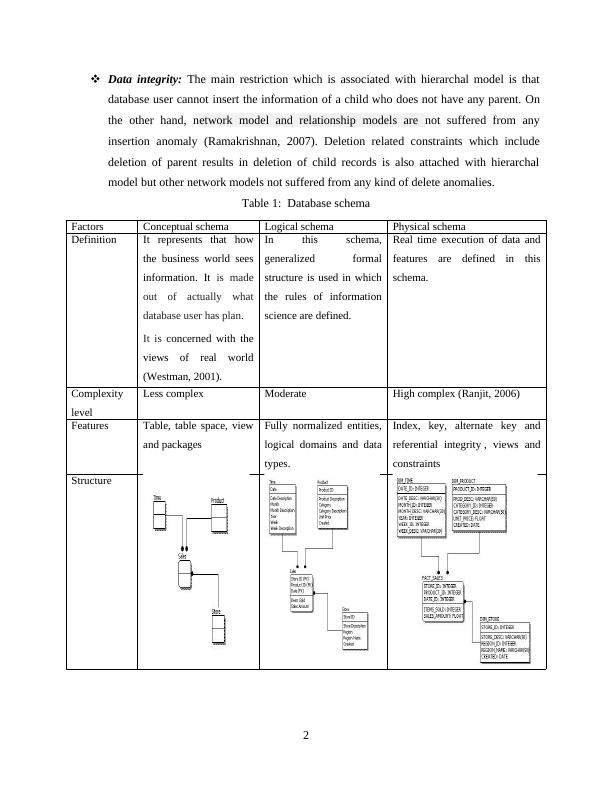
End of preview
Want to access all the pages? Upload your documents or become a member.
Related Documents
Database and Analytics (Database and Analytics) for the Auto Sale'slg...
|33
|5085
|217
Database and Analytics Principleslg...
|28
|3733
|30
Database Design and Developmentlg...
|23
|3990
|151
Database Design: Removal of data, De-Normalization, Constraints, Normal Form, Create Indexing, ER Diagram, Relational Schema, Create Procedureslg...
|21
|736
|54
Database Design and Implementation for Deskliblg...
|23
|5446
|415
Database Design Conceptlg...
|28
|5388
|245